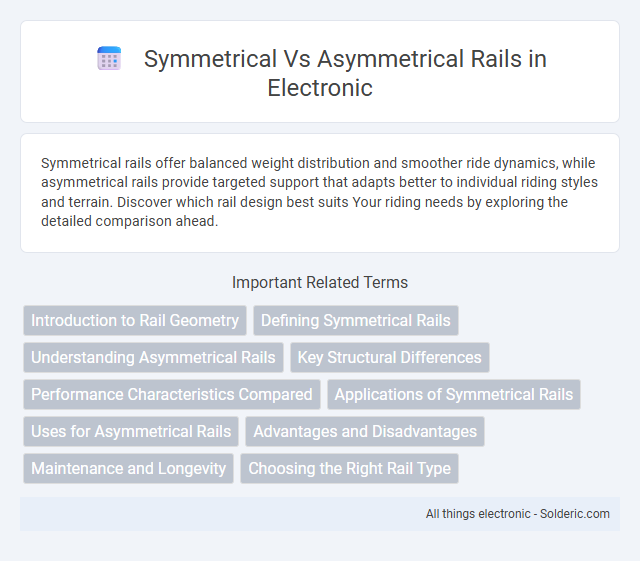Symmetrical rails offer balanced weight distribution and smoother ride dynamics, while asymmetrical rails provide targeted support that adapts better to individual riding styles and terrain. Discover which rail design best suits Your riding needs by exploring the detailed comparison ahead.
Comparison Table
| Feature | Symmetrical Rails | Asymmetrical Rails |
|---|---|---|
| Design | Identical shape on both sides | Different shapes on each side |
| Load Distribution | Uniform load distribution | Optimized for directional load |
| Applications | General-purpose railways | Specialized tracks, curves, and switches |
| Manufacturing Complexity | Simple and cost-effective | More complex, higher costs |
| Wear Resistance | Even wear on both sides | Wear optimized for dominant side |
| Installation | Easy installation and alignment | Requires precise orientation |
Introduction to Rail Geometry
Rail geometry plays a crucial role in the design and performance of railway tracks, with symmetrical and asymmetrical rails serving different functions. Symmetrical rails have identical profiles on both sides, providing consistent strength and wear resistance, while asymmetrical rails feature uneven profiles that optimize load distribution and reduce rail wear on curves. Understanding these differences helps you select the appropriate rail type to enhance track stability and extend maintenance intervals.
Defining Symmetrical Rails
Symmetrical rails feature evenly shaped profiles on both sides, offering consistent stability and balance for various applications such as railroads or electrical systems. These rails provide uniform support and load distribution, helping to reduce wear and enhance performance over time. Understanding symmetrical rails enables you to choose the right design for infrastructure projects that require reliable and predictable structural integrity.
Understanding Asymmetrical Rails
Asymmetrical rails feature unevenly shaped profiles designed to optimize performance under specific loading conditions by enhancing stability and reducing wear on one side. These rails are commonly used in applications where directional forces are predominant, improving track adherence and minimizing rail fatigue. Understanding the geometry and stress distribution of asymmetrical rails is critical for selecting the appropriate rail type to maximize durability and safety in railway infrastructure.
Key Structural Differences
Symmetrical rails feature a uniform cross-sectional profile on both sides, providing balanced structural integrity and consistent load distribution. Asymmetrical rails have differing shapes on each side, designed to accommodate specific load patterns or track geometry requirements, enhancing stability in certain rail applications. The key structural difference lies in the uniformity of the profile, with symmetrical rails offering equal strength on both sides, while asymmetrical rails optimize performance by varying cross-sectional dimensions.
Performance Characteristics Compared
Symmetrical rails provide consistent electrical performance and mechanical stability due to their uniform cross-section, ensuring balanced signal transmission with minimal reflection and impedance mismatch. Asymmetrical rails introduce variation in electromagnetic properties, which can optimize specific applications by reducing weight or focusing performance in one direction but may result in uneven signal quality or increased susceptibility to interference. Understanding the nuanced performance characteristics of symmetrical versus asymmetrical rails helps you select the ideal rail type tailored to your system's specific electrical and mechanical requirements.
Applications of Symmetrical Rails
Symmetrical rails are predominantly used in applications requiring uniform load distribution and consistent rail stability, such as heavy-duty railway tracks and industrial crane systems. Their identical profile on both sides ensures optimal alignment and balance, enhancing durability and reducing wear under high-stress conditions. When designing your infrastructure, choosing symmetrical rails can improve performance in environments demanding precise load management.
Uses for Asymmetrical Rails
Asymmetrical rails are primarily used in advanced firearm setups to enhance ergonomics and accessory mounting options, offering better clearance for optics and attachments like foregrips and lasers. These rails provide tailored support on one side, allowing shooters to customize their weapons for specific tactical needs or comfort during extended use. If you seek improved weapon handling and personalized configuration, asymmetrical rails offer distinct advantages over symmetrical designs.
Advantages and Disadvantages
Symmetrical rails offer uniformity, making track alignment and maintenance simpler due to consistent rail profiles on both sides, which enhances stability and load distribution. However, their design limits flexibility for specialized applications where directional strength or wear patterns differ. Asymmetrical rails provide targeted durability by optimizing rail heads for specific loads and directions, improving performance in curves and high-traffic areas, though they require more precise installation and higher maintenance costs due to uneven wear.
Maintenance and Longevity
Symmetrical rails offer uniform wear distribution, resulting in easier maintenance and extended longevity due to consistent load handling on both sides. Asymmetrical rails may require more frequent inspections and maintenance because uneven wear patterns can develop under variable loading conditions. Your choice between symmetrical and asymmetrical rails directly impacts maintenance schedules and overall rail lifespan, influencing operational efficiency and cost-effectiveness.
Choosing the Right Rail Type
Choosing the right rail type depends on the firearm's intended use, with symmetrical rails providing uniformity and ease of accessory alignment, making them ideal for precision shooting and consistent sight placement. Asymmetrical rails offer ergonomic advantages and enhanced grip comfort, benefiting tactical applications where quick handling and control are critical. Evaluating specific needs such as accessory compatibility, shooting style, and operational environment ensures selecting the optimal rail system for performance and reliability.
Symmetrical vs Asymmetrical rails Infographic

 solderic.com
solderic.com